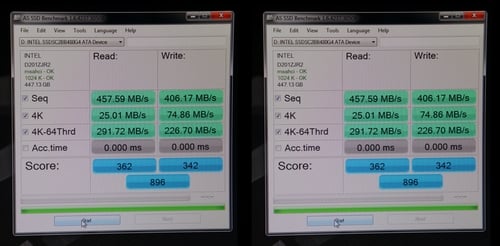Intel Demonstrates Overclocking SSDs At PAX Prime 2013 But Is It Worth It?
Are you willing to sacrifice a little data security to squeeze every last drop of performance out of your solid state drive? Intel wants to know.
At PAX Prime 2013, Intel hosted a short hands-on workshop showcasing their latest bleeding edge idea: overclocking SSDs. The demonstration was simple: run an Intel 480GB (6Gb/s SATA) SSD at stock speeds, then overclock the onboard controller, and then overclock the NAND bus frequency to demonstrate the performance improvement that can be achieved.
“The real question,” says Intel’s Product Marketing Manager Kei Kobayashi, “is whether or not we can squeeze enough performance out of the drive to justify the risk versus the reward.”
The Demo
We used AS SSD Benchmark v1.6 to first run a test of the SSD at standard speeds.

Intel 480GB SSD AS SSD Benchmark results with no overclocking
For the next test ,we used Intel’s Extreme Tuning Utility to increase the NAND bus frequency on the SSD from its default 83Mhz to 100Mhz, and then ran the test again. This yielded a very modest increase of around 20MB/s for sequential reads and 30MB/s for write speeds.

Intel SSD NAND overclock from 83Mhz to 100Mhz results
For the final test, we increased the SSD’s onboard microcontroller frequency from its stock 400Mhz speed all the way to 625Mhz. We also left the NAND bus frequency overclocked at 100 Mhz.

Intel 480GB SSD with both the NAND overclocked to 100Mhz
and the controller overclocked from 400Mhz to 625Mhz
This yielded a substantial increase in the 4K-64 (queue depth or 64 simultaneous requests for 4K chunks of data), increasing by roughly 20% from 292.53MB/s (read) and 229.69 MB/s (write) to 347.46MB/s and 288.88 MB/s, respectively.
Overclocking SSDs—is it worth it?
Currently, this is little more than the technological equivalent of a “concept car” for Intel. It may or may not result in SSD products promising the ability to overclock them. Intel is merely researching the idea while gauging customer interest.
“Until bigger questions are answered at an executive level, it’s just an idea at this point. There is no time table for delivering a product. Obviously, if we were to deliver a product based upon this technology, we would have to be very careful about how it was marketed. For example, do we limit the overclocking to ‘safe’ levels, or do we make it completely unrestricted?” Kobayashi explains.
“Also, on a side note, it doesn’t work with SSDs in a RAID configuration at the moment,” he continues.
Other PAX attendees in the hands-on demo expressed a wide range of feedback. “I’m concerned about the lifespan of the drive; I absolutely would not overclock an SSD,” one stated.
Other PAX attendees expressed varying levels of interest. “I like having better utilities to tweak and overclock,” said one. Yet a third was very enthusiastic for the technology and for Intel: “The ability to overclock an SSD is amazing. Intel has been lagging in the [SSD] market for a long time. It would be nice to see them come to the forefront a little more.”
As Koybayashi stated, however, until larger questions are answered we may or may not see a product line—perhaps a line of SSDs with modest overclocking capabilities, and/or a line of “Extreme” line with unrestricted overclocking?
And even if you could overclock an SSD, would you want to? Is the risk of data loss and/or frying a relatively expensive drive worth the performance gain?

